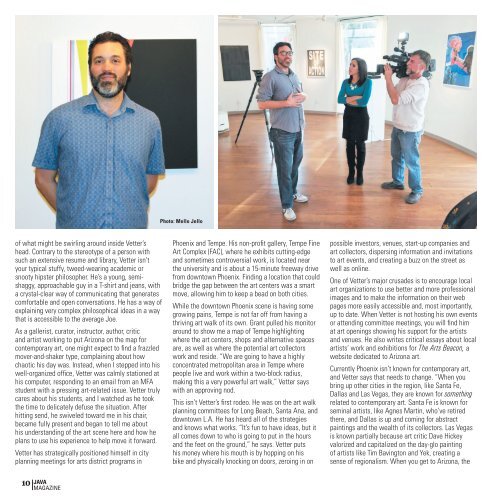Java.April.2017
Create successful ePaper yourself
Turn your PDF publications into a flip-book with our unique Google optimized e-Paper software.
Photo: Mello Jello<br />
of what might be swirling around inside Vetter’s<br />
head. Contrary to the stereotype of a person with<br />
such an extensive resume and library, Vetter isn’t<br />
your typical stuffy, tweed-wearing academic or<br />
snooty hipster philosopher. He’s a young, semishaggy,<br />
approachable guy in a T-shirt and jeans, with<br />
a crystal-clear way of communicating that generates<br />
comfortable and open conversations. He has a way of<br />
explaining very complex philosophical ideas in a way<br />
that is accessible to the average Joe.<br />
As a gallerist, curator, instructor, author, critic<br />
and artist working to put Arizona on the map for<br />
contemporary art, one might expect to find a frazzled<br />
mover-and-shaker type, complaining about how<br />
chaotic his day was. Instead, when I stepped into his<br />
well-organized office, Vetter was calmly stationed at<br />
his computer, responding to an email from an MFA<br />
student with a pressing art-related issue. Vetter truly<br />
cares about his students, and I watched as he took<br />
the time to delicately defuse the situation. After<br />
hitting send, he swiveled toward me in his chair,<br />
became fully present and began to tell me about<br />
his understanding of the art scene here and how he<br />
plans to use his experience to help move it forward.<br />
Vetter has strategically positioned himself in city<br />
planning meetings for arts district programs in<br />
Phoenix and Tempe. His non-profit gallery, Tempe Fine<br />
Art Complex (FAC), where he exhibits cutting-edge<br />
and sometimes controversial work, is located near<br />
the university and is about a 15-minute freeway drive<br />
from downtown Phoenix. Finding a location that could<br />
bridge the gap between the art centers was a smart<br />
move, allowing him to keep a bead on both cities.<br />
While the downtown Phoenix scene is having some<br />
growing pains, Tempe is not far off from having a<br />
thriving art walk of its own. Grant pulled his monitor<br />
around to show me a map of Tempe highlighting<br />
where the art centers, shops and alternative spaces<br />
are, as well as where the potential art collectors<br />
work and reside. “We are going to have a highly<br />
concentrated metropolitan area in Tempe where<br />
people live and work within a two-block radius,<br />
making this a very powerful art walk,” Vetter says<br />
with an approving nod.<br />
This isn’t Vetter’s first rodeo. He was on the art walk<br />
planning committees for Long Beach, Santa Ana, and<br />
downtown L.A. He has heard all of the strategies<br />
and knows what works. “It’s fun to have ideas, but it<br />
all comes down to who is going to put in the hours<br />
and the feet on the ground,” he says. Vetter puts<br />
his money where his mouth is by hopping on his<br />
bike and physically knocking on doors, zeroing in on<br />
possible investors, venues, start-up companies and<br />
art collectors, dispersing information and invitations<br />
to art events, and creating a buzz on the street as<br />
well as online.<br />
One of Vetter’s major crusades is to encourage local<br />
art organizations to use better and more professional<br />
images and to make the information on their web<br />
pages more easily accessible and, most importantly,<br />
up to date. When Vetter is not hosting his own events<br />
or attending committee meetings, you will find him<br />
at art openings showing his support for the artists<br />
and venues. He also writes critical essays about local<br />
artists’ work and exhibitions for The Arts Beacon, a<br />
website dedicated to Arizona art.<br />
Currently Phoenix isn’t known for contemporary art,<br />
and Vetter says that needs to change. “When you<br />
bring up other cities in the region, like Santa Fe,<br />
Dallas and Las Vegas, they are known for something<br />
related to contemporary art. Santa Fe is known for<br />
seminal artists, like Agnes Martin, who’ve retired<br />
there, and Dallas is up and coming for abstract<br />
paintings and the wealth of its collectors. Las Vegas<br />
is known partially because art critic Dave Hickey<br />
valorized and capitalized on the day-glo painting<br />
of artists like Tim Bavington and Yek, creating a<br />
sense of regionalism. When you get to Arizona, the<br />
10 JAVA<br />
MAGAZINE


















